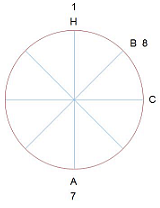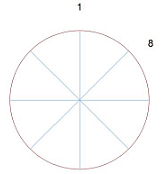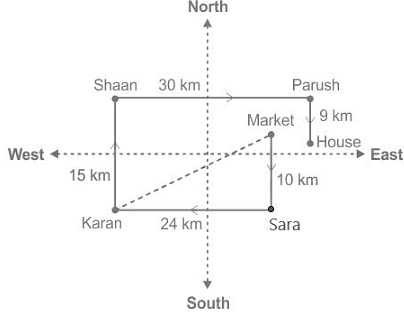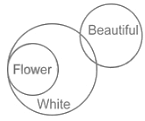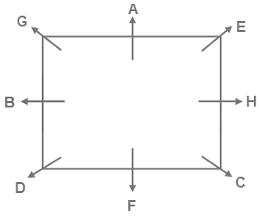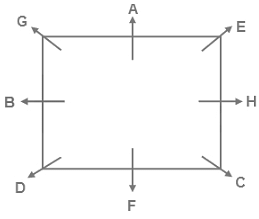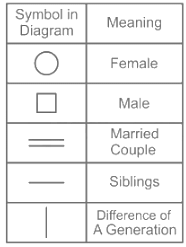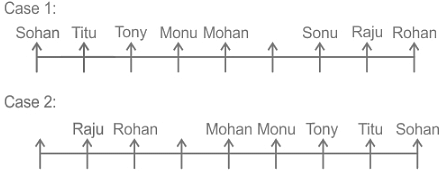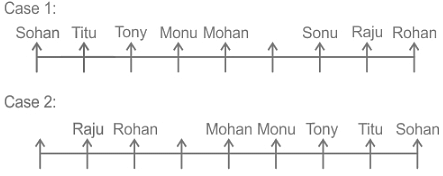IBPS RRB PO (Scale 1) Prelims Mock Test - 4 - Bank Exams MCQ
30 Questions MCQ Test Mock Tests for Banking Exams 2024 - IBPS RRB PO (Scale 1) Prelims Mock Test - 4
Directions: Read the information carefully and answer the question asked below.
Eight persons A, B, C, D, E, F, G, and H are sitting around a campfire in a circle. All of them have a unique number of marble stones from 1 to 8. All of them are facing the fire.
Further, the following information is known.
There are 2 persons sitting between the person 7 marbles and 8 marbles.
The person with the most number of marbles is sitting adjacent to the person with the least number of marbles.
The person with the second-highest number of marbles is sitting opposite the person with the least number of marbles and adjacent to the person with the second-lowest number of marbles.
None of the neighbors of the person with the highest number of marbles has an even number of marbles.
The person who is sitting opposite the person with 3 marbles has 6 marbles. Neither of them is adjacent to the person with the most number of marbles.
A is the person with 7 marbles. B is the person with 8 marbles. H and C are neighbors of B. C does not have the least number of marbles. E, who has 4 marbles, is sitting opposite the person with 5 marbles. D is a neighbor of H. G sits opposite to the person with the most number of marbles. F has an odd number of marbles.
Q. Who has 6 marbles?
There are 2 persons sitting between the person 7 marbles and 8 marbles.
The person with the most number of marbles is sitting adjacent to the person with the least number of marbles.
The person with the second-highest number of marbles is sitting opposite the person with the least number of marbles and adjacent to the person with the second-lowest number of marbles.
None of the neighbors of the person with the highest number of marbles has an even number of marbles.
The person who is sitting opposite the person with 3 marbles has 6 marbles. Neither of them is adjacent to the person with the most number of marbles.
A is the person with 7 marbles. B is the person with 8 marbles. H and C are neighbors of B. C does not have the least number of marbles. E, who has 4 marbles, is sitting opposite the person with 5 marbles. D is a neighbor of H. G sits opposite to the person with the most number of marbles. F has an odd number of marbles.
Directions: Read the information carefully and answer the question asked below.
Eight persons A, B, C, D, E, F, G, and H are sitting around a campfire in a circle. All of them have a unique number of marble stones from 1 to 8. All of them are facing the fire.
Further, the following information is known.
There are 2 persons sitting between the person 7 marbles and 8 marbles.
The person with the most number of marbles is sitting adjacent to the person with the least number of marbles.
The person with the second-highest number of marbles is sitting opposite the person with the least number of marbles and adjacent to the person with the second-lowest number of marbles.
None of the neighbors of the person with the highest number of marbles has an even number of marbles.
The person who is sitting opposite the person with 3 marbles has 6 marbles. Neither of them is adjacent to the person with the most number of marbles.
A is the person with 7 marbles. B is the person with 8 marbles. H and C are neighbors of B. C does not have the least number of marbles. E, who has 4 marbles, is sitting opposite the person with 5 marbles. D is a neighbor of H. G sits opposite to the person with the most number of marbles. F has an odd number of marbles.
Q. What is the sum of the number of marbles that the neighbours of the person with the least number of marble have?
There are 2 persons sitting between the person 7 marbles and 8 marbles.
The person with the most number of marbles is sitting adjacent to the person with the least number of marbles.
The person with the second-highest number of marbles is sitting opposite the person with the least number of marbles and adjacent to the person with the second-lowest number of marbles.
None of the neighbors of the person with the highest number of marbles has an even number of marbles.
The person who is sitting opposite the person with 3 marbles has 6 marbles. Neither of them is adjacent to the person with the most number of marbles.
A is the person with 7 marbles. B is the person with 8 marbles. H and C are neighbors of B. C does not have the least number of marbles. E, who has 4 marbles, is sitting opposite the person with 5 marbles. D is a neighbor of H. G sits opposite to the person with the most number of marbles. F has an odd number of marbles.
| 1 Crore+ students have signed up on EduRev. Have you? Download the App |
Directions: Read the information carefully and answer the question asked below.
Eight persons A, B, C, D, E, F, G, and H are sitting around a campfire in a circle. All of them have a unique number of marble stones from 1 to 8. All of them are facing the fire.
Further, the following information is known.
There are 2 persons sitting between the person 7 marbles and 8 marbles.
The person with the most number of marbles is sitting adjacent to the person with the least number of marbles.
The person with the second-highest number of marbles is sitting opposite the person with the least number of marbles and adjacent to the person with the second-lowest number of marbles.
None of the neighbors of the person with the highest number of marbles has an even number of marbles.
The person who is sitting opposite the person with 3 marbles has 6 marbles. Neither of them is adjacent to the person with the most number of marbles.
A is the person with 7 marbles. B is the person with 8 marbles. H and C are neighbors of B. C does not have the least number of marbles. E, who has 4 marbles, is sitting opposite the person with 5 marbles. D is a neighbor of H. G sits opposite to the person with the most number of marbles. F has an odd number of marbles.
Q. For how many persons can we determine the number of marbles they have?
There are 2 persons sitting between the person 7 marbles and 8 marbles.
The person with the most number of marbles is sitting adjacent to the person with the least number of marbles.
The person with the second-highest number of marbles is sitting opposite the person with the least number of marbles and adjacent to the person with the second-lowest number of marbles.
None of the neighbors of the person with the highest number of marbles has an even number of marbles.
The person who is sitting opposite the person with 3 marbles has 6 marbles. Neither of them is adjacent to the person with the most number of marbles.
A is the person with 7 marbles. B is the person with 8 marbles. H and C are neighbors of B. C does not have the least number of marbles. E, who has 4 marbles, is sitting opposite the person with 5 marbles. D is a neighbor of H. G sits opposite to the person with the most number of marbles. F has an odd number of marbles.
Directions: Read the information carefully and answer the question asked below.
Eight persons A, B, C, D, E, F, G, and H are sitting around a campfire in a circle. All of them have a unique number of marble stones from 1 to 8. All of them are facing the fire.
Further, the following information is known.
There are 2 persons sitting between the person 7 marbles and 8 marbles.
The person with the most number of marbles is sitting adjacent to the person with the least number of marbles.
The person with the second-highest number of marbles is sitting opposite the person with the least number of marbles and adjacent to the person with the second-lowest number of marbles.
None of the neighbors of the person with the highest number of marbles has an even number of marbles.
The person who is sitting opposite the person with 3 marbles has 6 marbles. Neither of them is adjacent to the person with the most number of marbles.
A is the person with 7 marbles. B is the person with 8 marbles. H and C are neighbors of B. C does not have the least number of marbles. E, who has 4 marbles, is sitting opposite the person with 5 marbles. D is a neighbor of H. G sits opposite to the person with the most number of marbles. F has an odd number of marbles.
Q. Who has 5 marbles?
Directions: Read the information carefully and answer the question asked below.
Eight persons A, B, C, D, E, F, G, and H are sitting around a campfire in a circle. All of them have a unique number of marble stones from 1 to 8. All of them are facing the fire.
Further, the following information is known.
There are 2 persons sitting between the person 7 marbles and 8 marbles.
The person with the most number of marbles is sitting adjacent to the person with the least number of marbles.
The person with the second-highest number of marbles is sitting opposite the person with the least number of marbles and adjacent to the person with the second-lowest number of marbles.
None of the neighbors of the person with the highest number of marbles has an even number of marbles.
The person who is sitting opposite the person with 3 marbles has 6 marbles. Neither of them is adjacent to the person with the most number of marbles.
A is the person with 7 marbles. B is the person with 8 marbles. H and C are neighbors of B. C does not have the least number of marbles. E, who has 4 marbles, is sitting opposite the person with 5 marbles. D is a neighbor of H. G sits opposite to the person with the most number of marbles. F has an odd number of marbles.
Q. How many marbles does G have?
Directions: In the given questions three statements are followed by two conclusions I and II. You have to assume everything in the statements to be true even if they seem to be at variance with commonly known facts, and then decide which of the given conclusions logically follows from the statements disregarding the commonly known facts.
Statements:
Some Adidas are Lava.
Some Lava are Iron.
Some Iron are Samsung.
Some Samsung are Rod.
Conclusions:
I. Some Lava are Adidas.
II. Some Samsung are Lava.
Directions: In the given questions three statements are followed by two conclusions I and II. You have to assume everything in the statements to be true even if they seem to be at variance with commonly known facts, and then decide which of the given conclusions logically follows from the statements disregarding the commonly known facts.
Statements:
No man is handsome.
Some handsome are peoples.
All peoples are mad.
Conclusions:
I. All men being mad is a possibility.
II. No man is a people.
Directions: Study the information given below carefully and answer the questions that follow.
Sara goes 10 km South from the Market, takes a right turn and goes 24 km to meet Karan. She then goes 15 km North and meets Shaan. She then turns right and goes 30 km to meet Parush. She further goes 9 km South to reach her house and stops there.
Q. What is the shortest distance between the market and Karan?
Directions: Study the information given below carefully and answer the questions that follow.
Sara goes 10 km South from the Market, takes a right turn and goes 24 km to meet Karan. She then goes 15 km North and meets Shaan. She then turns right and goes 30 km to meet Parush. She further goes 9 km South to reach her house and stops there.
Q. What is the shortest distance between Shaan and Sara’s House?
Directions: Study the information given below carefully and answer the questions that follow.
Sara goes 10 km South from the Market, takes a right turn and goes 24 km to meet Karan. She then goes 15 km North and meets Shaan. She then turns right and goes 30 km to meet Parush. She further goes 9 km South to reach her house and stops there.
Q. What is the direction of Parush from the Market?
Directions: In the question below are given a few statements followed by some conclusions. You have to take the given statements to be true even if they seem to be at variance with commonly known facts. Read all the conclusions and then decide which of the given conclusions logically follows from the given statements, disregarding commonly known facts.
Statements:
All flowers are white.
Some whites are beautiful.
Conclusions:
I. All flowers being beautiful is a possibility.
II. At least some white may not be flowers.
Directions: In the question below are given a few statements followed by some conclusions. You have to take the given statements to be true even if they seem to be at variance with commonly known facts. Read all the conclusions and then decide which of the given conclusions logically follows from the given statements, disregarding commonly known facts.
Statements:
Some leaves are not poles.
Some pots are poles.
Only few trees are pots.
All pots are branches.
Conclusions:
I. A few pots are not tree.
II. Some branches are leaves is a possibility.
III. Some tree are not pots.
Directions: In the question below are given a few statements followed by some conclusions. You have to take the given statements to be true even if they seem to be at variance with commonly known facts. Read all the conclusions and then decide which of the given conclusions logically follows from the given statements, disregarding commonly known facts.
Statements:
10 % population is infected
40 % infected is cured.
Conclusions:
1) Some population is cured
2) 5 % of the infected population is cured
3) Some cured is infected
Directions: Study the following information carefully to answer the given questions:
Step 1: Odd numbers which are a perfect square are written at the right end in descending order.
Step 2: After completing step 1, consonants to be changed to the next letter in alphabetical order.
Step 3: After completing step 2, vowels to be changed to A.
Input: C → K 5 R ÷ 6 N ( G © 9 F 4 U T 8 ) µ M F #
Q. How many consonants are followed by a symbol after step 1?
Directions: Study the following information carefully to answer the given questions:
Step 1: Odd numbers which are a perfect square are written at the right end in descending order.
Step 2: After completing step 1, consonants to be changed to the next letter in alphabetical order.
Step 3: After completing step 2, vowels to be changed to A.
Input: C → K 5 R ÷ 6 N ( G © 9 F 4 U T 8 ) µ M F #
Q. Which element is 4th to the right of the twentieth element from the right end after step 2?
Directions: Study the following information carefully to answer the given questions:
Step 1: Odd numbers which are a perfect square are written at the right end in descending order.
Step 2: After completing step 1, consonants to be changed to the next letter in alphabetical order.
Step 3: After completing step 2, vowels to be changed to A.
Input: C → K 5 R ÷ 6 N ( G © 9 F 4 U T 8 ) µ M F #
Q. How many perfect square immediately preceded by a symbol after step 3?
Directions: Read the following information carefully and answer the questions that follow:
A, B, C, D, E, F, G, and H are sitting around a square table facing away from the table in such a way that four of them sit at the four corners of the square table while the remaining four sit in the middle of each of the four sides. Only three people sit between A and F. C is sitting third to the right of A. F is an immediate neighbour of C and D. H is sitting second to the right of A. H is not an immediate neighbour of G. Both A and F are sitting middle of the table. A is not an immediate neighbour of B.
Q. E is related to B. In the same manner, who is related to D?
Directions: Read the following information carefully and answer the questions that follow:
A, B, C, D, E, F, G, and H are sitting around a square table facing away from the table in such a way that four of them sit at the four corners of the square table while the remaining four sit in the middle of each of the four sides. Only three people sit between A and F. C is sitting third to the right of A. F is an immediate neighbour of C and D. H is sitting second to the right of A. H is not an immediate neighbour of G. Both A and F are sitting middle of the table. A is not an immediate neighbour of B.
Q. Who is sitting fourth to the right of F?
Directions: Read the following information carefully and answer the questions that follow:
A, B, C, D, E, F, G, and H are sitting around a square table facing away from the table in such a way that four of them sit at the four corners of the square table while the remaining four sit in the middle of each of the four sides. Only three people sit between A and F. C is sitting third to the right of A. F is an immediate neighbour of C and D. H is sitting second to the right of A. H is not an immediate neighbour of G. Both A and F are sitting middle of the table. A is not an immediate neighbour of B.
Q. What is the position of E with respect to G?
Directions: Read the following information carefully and answer the questions that follow:
A, B, C, D, E, F, G, and H are sitting around a square table facing away from the table in such a way that four of them sit at the four corners of the square table while the remaining four sit in the middle of each of the four sides. Only three people sit between A and F. C is sitting third to the right of A. F is an immediate neighbour of C and D. H is sitting second to the right of A. H is not an immediate neighbour of G. Both A and F are sitting middle of the table. A is not an immediate neighbour of B.
Q. Four of the following are alike. Which one does not follow the group?
Directions: Read the following information carefully and answer the questions that follow:
A, B, C, D, E, F, G, and H are sitting around a square table facing away from the table in such a way that four of them sit at the four corners of the square table while the remaining four sit in the middle of each of the four sides. Only three people sit between A and F. C is sitting third to the right of A. F is an immediate neighbour of C and D. H is sitting second to the right of A. H is not an immediate neighbour of G. Both A and F are sitting middle of the table. A is not an immediate neighbour of B.
Q. How many people sit between B and F, when counted from left of B?
Directions: In the following question assuming the given statement to be true, find which of the conclusion among the given three conclusions is /are definitely true and then give your answers accordingly.
Statements:
A = B = C > D > E, C < P < Q
Conclusions:
I. A > E
II. E < B
III. Q < D
Directions: In the following question assuming the given statement to be true, find which of the conclusion among the given three conclusions is /are definitely true and then give your answers accordingly.
Statements:
X > Y > Z > R; P > Q > R
Conclusions:
I. X > Q
II. R < Y
III. Z = Q
Directions: Study the given information carefully and answer the following questions.
Sonu is the mother of Amu, who is the only sister of Chan. John is the only son of Dia, who is the wife of Raj. Chan is the only son of Balu, who is the brother of Raj. Lata is the sister of Balu.
Q. How Amu is related to Lata?
Directions: Study the given information carefully and answer the following questions.
Sonu is the mother of Amu, who is the only sister of Chan. John is the only son of Dia, who is the wife of Raj. Chan is the only son of Balu, who is the brother of Raj. Lata is the sister of Balu.
Q. How is Lata related to Dia?
Directions: Study the following information and answer the given questions:
Nine persons Sonu, Raju, Monu, Tony, Titu, Sanju, Mohan, Sohan, and Rohan are seated in a row facing North. Mohan is sitting exactly in the middle of the row. Two people sits between Mohan and Raju. Rohan sits to the immediate right of Raju. Sohan sits at one of the extreme ends of the row. One person sits between Sohan and Tony. Titu is not an immediate neighbour of Mohan and Raju. Monu is an immediate neighbour of Tony. Sonu is not an immediate neighbour of Mohan and is not sitting at the end of the row.
Q. How many persons are sitting between Rohan and Monu?
Directions: Study the following information and answer the given questions:
Nine persons Sonu, Raju, Monu, Tony, Titu, Sanju, Mohan, Sohan, and Rohan are seated in a row facing North. Mohan is sitting exactly in the middle of the row. Two people sits between Mohan and Raju. Rohan sits to the immediate right of Raju. Sohan sits at one of the extreme ends of the row. One person sits between Sohan and Tony. Titu is not an immediate neighbour of Mohan and Raju. Monu is an immediate neighbour of Tony. Sonu is not an immediate neighbour of Mohan and is not sitting at the end of the row.
Q. Who sits third to the right of Sohan?
Directions: Study the following information and answer the given questions:
Nine persons Sonu, Raju, Monu, Tony, Titu, Sanju, Mohan, Sohan, and Rohan are seated in a row facing North. Mohan is sitting exactly in the middle of the row. Two people sits between Mohan and Raju. Rohan sits to the immediate right of Raju. Sohan sits at one of the extreme ends of the row. One person sits between Sohan and Tony. Titu is not an immediate neighbour of Mohan and Raju. Monu is an immediate neighbour of Tony. Sonu is not an immediate neighbour of Mohan and is not sitting at the end of the row.
Q. Which of the following condition is true regarding Titu?
Directions: Study the following information and answer the given questions:
Nine persons Sonu, Raju, Monu, Tony, Titu, Sanju, Mohan, Sohan, and Rohan are seated in a row facing North. Mohan is sitting exactly in the middle of the row. Two people sits between Mohan and Raju. Rohan sits to the immediate right of Raju. Sohan sits at one of the extreme ends of the row. One person sits between Sohan and Tony. Titu is not an immediate neighbour of Mohan and Raju. Monu is an immediate neighbour of Tony. Sonu is not an immediate neighbour of Mohan and is not sitting at the end of the row.
Q. What is the position of Tony with respect to Raju?
Directions: Study the following information and answer the given questions:
Nine persons Sonu, Raju, Monu, Tony, Titu, Sanju, Mohan, Sohan, and Rohan are seated in a row facing North. Mohan is sitting exactly in the middle of the row. Two people sits between Mohan and Raju. Rohan sits to the immediate right of Raju. Sohan sits at one of the extreme ends of the row. One person sits between Sohan and Tony. Titu is not an immediate neighbour of Mohan and Raju. Monu is an immediate neighbour of Tony. Sonu is not an immediate neighbour of Mohan and is not sitting at the end of the row.
Q. Who is sitting between Mohan and Sonu?
|
160 tests
|









